
Digital marketers and website owners are always looking for ways to improve site SEO. Common strategies involve adding valuable content, optimizing page titles, choosing appropriate keywords, and obtaining backlinks. But beyond these SEO staples lie less obvious tactics.
One of these tactics is utilizing image metadata. While the significance of metadata is ever-changing in the evolving world of technology, it is important to stay at the forefront of what opportunities image metadata presents.
Let’s take a look at what image metadata is and what benefits are found in including it in, or removing it from, a file.
What is Image Metadata?
Image metadata is invisible data attached to an image file that provides information about the image.
This data can include the image creation date, location, instructions for use, keywords, copyright information, or anything else that may pertain to the file. It is stored as code, the most common of which is called EXIF data, and is often created by the camera itself when a photo is created.
The metadata we will discuss in this post is attached to the file itself, but metadata can also be external to the file in a digital asset management system, in the same way a customer management system stores information about clients.
How to View Metadata
Internal EXIF metadata can only be seen by looking at the image’s properties in the operating system or by using an image viewer like Photoshop.
Luckily, viewing and editing image metadata is easy within Windows or Mac OSX.
On Windows:
1. Right-click on the target image file and choose ‘Properties’.
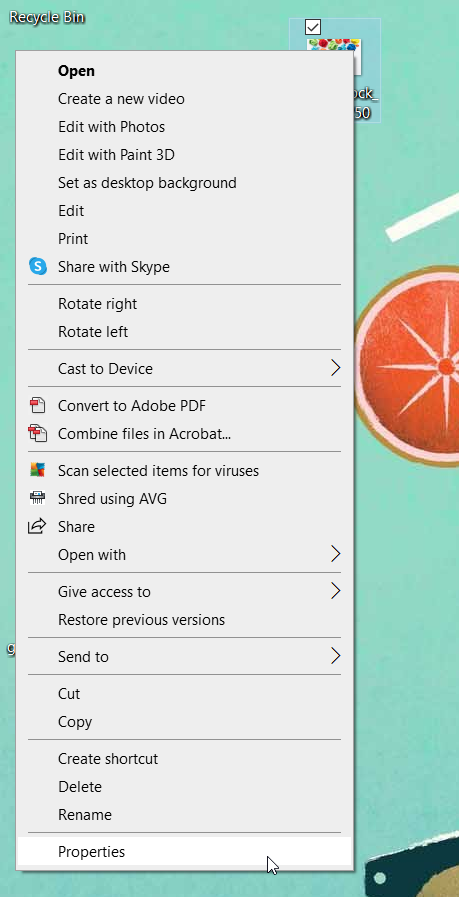
2. Click on the ‘Details’ tab to see all EXIF data about the image.
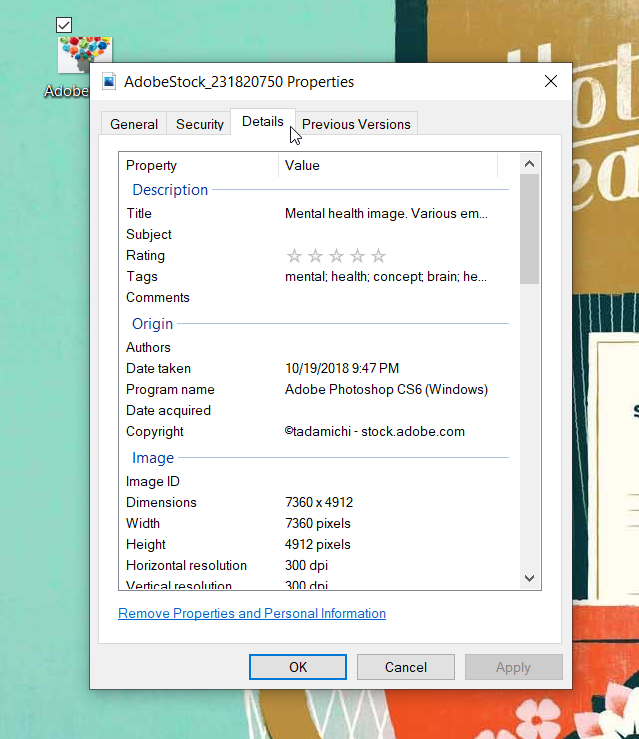
On Mac OSX:
1. Open the target image in Preview.
2. Click on ‘Tools’ in the menu bar at the top of the screen and choose ‘Show Inspector’.
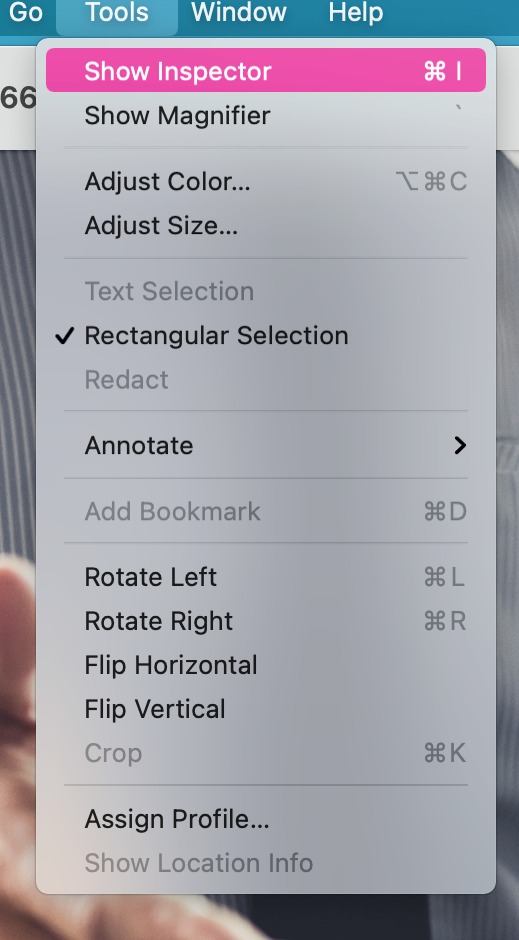
3. Click on the ‘More info’ tab, then the ‘Exif’ tab to view image metadata.
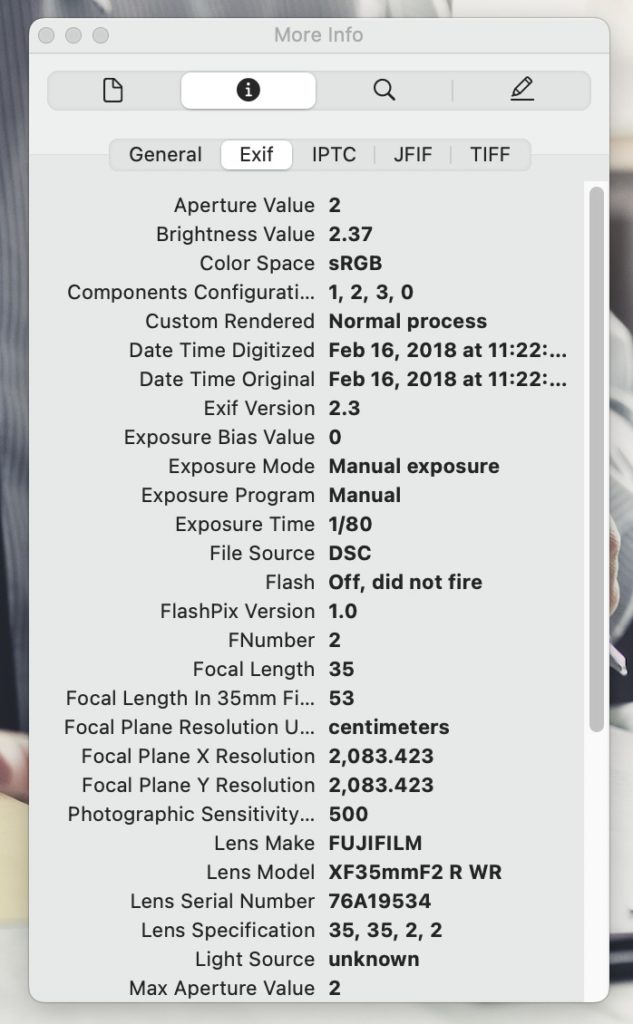
Page speed and Image Metadata
The larger the file, the more likely it is to slow down webpage speed when it loads. Each time a page fetches a file, it spends time ‘downloading’ it to the page, which takes time.
According to a study by web optimization company Dexecure, metadata accounts for an average of 16% of an image file’s size. While image metadata doesn’t eat up a lot of space per file, pages with hundreds of images can start to slow down as the data adds up.
Later, we will discuss cases where including image metadata can be beneficial. If none of these “beneficial” situations apply to your site, however, we recommend removing metadata to keep page speed fast.
Site Security and Image Metadata
Anyone else on the internet can view image metadata as easily as we did above. While, most of the time, this information is not harmful, any metadata attached to an image is free for anyone on the entire internet to view.
For example, leaving metadata attached to images while performing an illegal activity ended poorly for one photographer. Authorities discovered he was working in a state park without a permit because they left date and location metadata attached to their images.
Another poster, TechTV host Catherine Schwartz, posted two cropped photos of herself on her blog. Unfortunately, she did not erase the thumbnail image metadata and the file exposed the original, uncropped images — of her topless (whoops!).
The relationship between image metadata and security has turned into a “better safe than sorry” situation as technology continually changes. If you’re worried about anything surrounding an image becoming public, it’s best to just remove all metadata.
When Is Metadata Helpful?
Image metadata is not always about slowing down sites and getting caught breaking the law. Metadata does serve a purpose in some cases. Here are some instances where it may be helpful to keep metadata in your images:
- Artists use copyright metadata on images to keep people from stealing their intellectual property. In an online survey conducted by IMATAG, 82% of respondents said that they use metadata to protect their images from piracy. While this method is not foolproof, it’s an important part of keeping artistic works safe.
- Image metadata also provides useful information about images. Much like alt attributes (external metadata not covered here), it could be helpful to visitors to be able to access that data and learn more about the file.
- If you’re looking to optimize for Google’s future of visual search or gain credibility on local search, metadata like image description and geotagging may be beneficial.
Overall SEO Impact
So, is it better for SEO to keep metadata or remove it? The answer is… it depends. If your page speed is already running slow, and you have a lot of images, it’s a good idea to just get rid of it. But if you think it could be good for local SEO or your site has no speed issues, metadata may help you.
In 2014, Google addressed the question of EXIF data being used as a ranking factor. Like many of Google’s responses, the answer is vague:
From Matt Cutts at Google, about using image metadata in SEO ranking:
“We reserve the right to. We can parse the data, and we have displayed it at one time or another in search results… You should use it if it is available, but don’t go out of your way to add it retrospectively. We might use it. We might not.”
🤔
While 2014 is about a million years ago in SEO time, nothing has changed in Google’s ability to access and use image metadata if they so choose. So, it’s not confirmed — but neither are a lot of SEO strategies.
How to Edit or Remove Metadata
If you decide to remove image metadata on Windows or want to change the current metadata, you can start with the same process used to view it above. Since Mac OSX doesn’t offer editing capabilities in Finder, the process is slightly different.
On Windows
1. In the ‘Details’ tab, double-click on the field data that you want to change, enter new information, then click ‘OK’ or ‘Apply’.
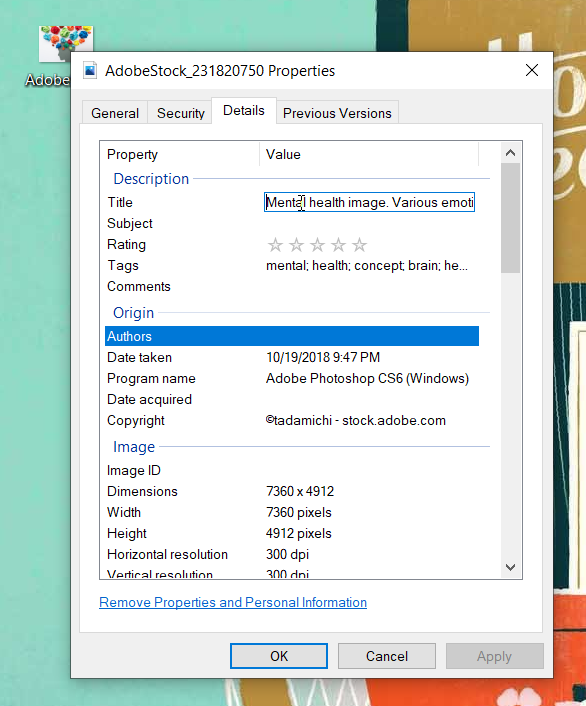
2. To remove metadata, click on ‘Remove Properties and Personal Information’.
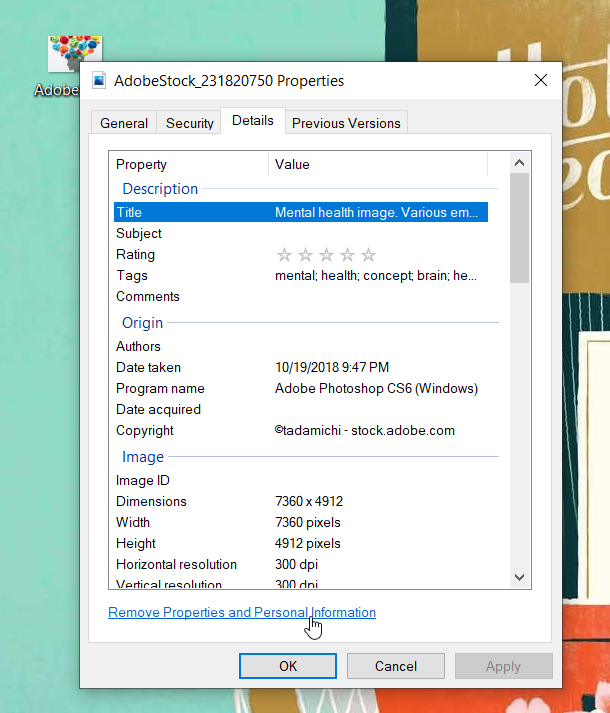
a. To remove all information, choose the ‘Create a copy with all possible properties removed’ radio button.
b. To remove only some information, choose the ‘Remove the following properties from this file’ radio button and choose what fields to delete. Then click ‘OK’.
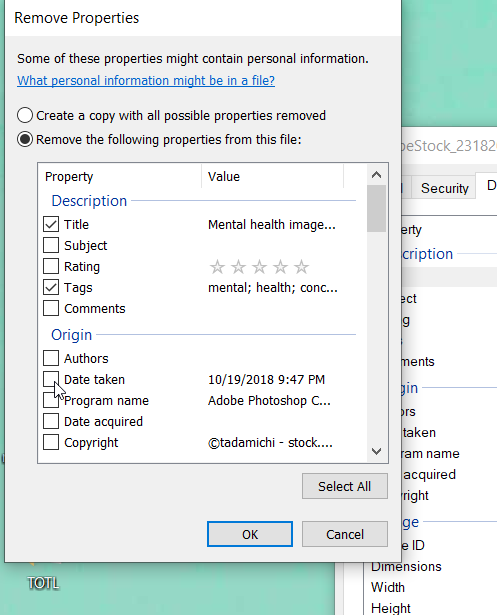
On Mac OSX
Using AnyExif:
- Go to https://anyexif.com/
- Click the “Download from MacStore” button and follow the instructions to download
- Follow instructions at https://anyexif.com/edit-photo-exif-mac.html about how to view or modify data with the app. They also provide detailed instructions about how to edit specific data like GPS location and camera information.
Using The Exifier:
- Go to https://www.thexifer.net/
- Click ‘Upload’ to upload a file or fetch from one of the services listed on the other buttons.
- After you upload the file, click ‘eXif.me’ button.
- Edit any information in the fields.
- To remove all Exif data, click the box next to ‘IF CHECKED ALL THE TAGS WILL BE CLEARED’.
- Once finished, click ‘Go.eXifing’ in the bottom right corner.
- Upon confirmation, click the ‘Close The Editor’ button.
- Under the file thumbnail, click ‘Download.me’. The download will automatically start.
The Future of Image Metadata
The use of image metadata is a part of a custom strategy based on website needs.
There are pros and cons to including it in a file. Luckily, metadata is fairly easy to manage. If you aren’t sure you want to remove metadata from a file permanently, save a copy of the file with metadata removed in addition to the original. This way, you can switch the file if your strategy changes.
Clearly, the technology for Google to use metadata in its algorithm is in place. It’s difficult to predict what changes the search engine will make to its ranking, so consider this context when choosing how to approach image metadata.
Whichever way you proceed, it’s a good idea to keep an eye on changing image metadata trends in order to use this opportunity to its fullest potential.
About the Author

Mandie joined Top Of The List in 2018 and has a degree in Web Development. She lives in Grand Rapids, MI with her dog Winnie.





Another informative article! Easy to understand!